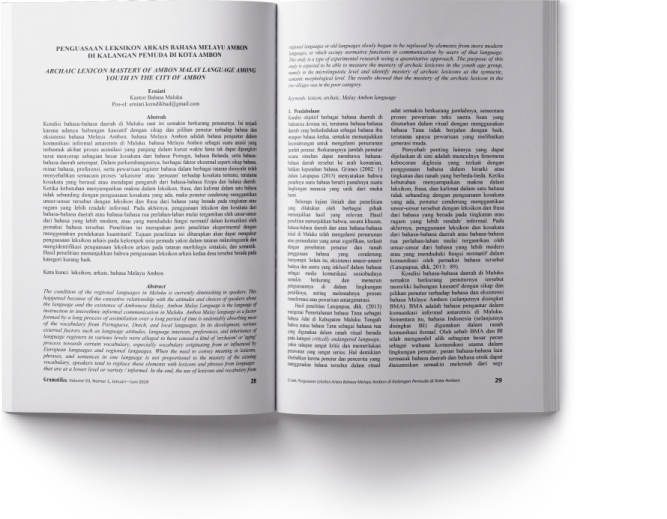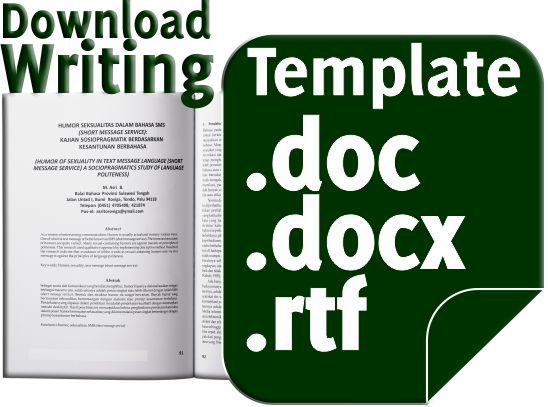ARCHAIC LEXICON MASTERY OF AMBON MALAY LANGUAGE AMONG YOUTH IN THE CITY OF AMBON
Abstract
The condition of the regional languages in Maluku is currently diminishing in speakers. This happened because of the causative relationship with the attitudes and choices of speakers about the language and the existence of Ambonese Malay. Ambon Malay Language is the language of instruction in interethnic informal communication in Maluku. Ambon Malay language as a factor formed by a long process of assimilation over a long period of time is undeniably absorbing most of the vocabulary from Portuguese, Dutch, and local languages. In its development, various external factors such as language attitudes, language interests, preferences, and inheritance of language registers in various levels were alleged to have caused a kind of 'archaism' or 'aging' process towards certain vocabulary, especially vocabulary originating from or influenced by European languages and regional languages. When the need to convey meaning in lexicons, phrases, and sentences in one language is not proportional to the mastery of the existing vocabulary, speakers tend to replace these elements with lexicons and phrases from languages that are at a lower level or variety / informal. In the end, the use of lexicons and vocabulary from regional languages or old languages slowly began to be replaced by elements from more modern languages, or which occupy normative functions in communication by users of that language. This study is a type of experimental research using a quantitative approach. The purpose of this study is expected to be able to measure the mastery of archaic lexicons in the youth age group, namely in the microlinguistic level and identify mastery of archaic lexicons at the syntactic, semantic morphological level. The results showed that the mastery of the archaic lexicon in the two villages was in the poor category.
References
Arikunto. (2005). Metode Penelitian:Populasi dan Sampel.Yogyakarta: Pustaka Pelajar.
Kadir, Hatib Abdul. (2009). Bergaya di Kota Konflik-Mencari Akar Konflik Ambon Melalui Gaya Hidup Anak Muda.Yogyakarta: Pustaka Pelajar.
----------------. (2009). “Nyong Ambon Punya Gaya”: Imajinasi Gaya dan Identitas Tubuh Anak Muda Kota Ambon”. Makalah disampaikan dalam diskusi buku "Bergaya di Kota Konflik-Mencari Akar Konflik Ambon Melalui Gaya Hidup Anak Muda" tanggal 26 Maret 2009. Salatiga: Pusat Studi Kawasan Timur Indonesia Universitas Kristen Satya Wacana.
Latupapua, F. E., dkk. (2012). Kapata: Sastra Lisan di Maluku Tengah. Ambon: Balai Pengkajian Nilai Budaya Provinsi Maluku dan Maluku Utara.
------------------. (2013). “Pemertahanan bahasa Tana sebagai bahasa Adat di Kabupaten Maluku Tengah”. Laporan Penelitian Hibah Bersaing pada Lembaga Penelitian Universitas Pattimura: Tidak diterbitkan.
Nurgiyantoro, Burhan. (1987). Penilaian Dalam Pengajaran bahasa dan Sastra. Yogyakarta: BPTE.
Omar, Asmah Hj. (1991). Bahasa Melayu Abad Ke-16: Satu Analisis Berdasarkan Teks Melayu Aqaid al-Nasafi. Kuala Lumpur: Dewan bahasa dan Pustaka.
Patton, Michael Quinn. (2011). Metode Evaluasi Kualitatif. Jakarta: Patawa Publishing.
Pesiwarissa, Leonora F. (2009). “Konstituen “e“ dalam bahasa Melayu Ambon (Suatu Kajian Sintaksis). Skripsi Program Studi Pendidikan bahasa dan Sastra Indonesia, Jurusan bahasa dan Seni Fakultas Keguruan dan Ilmu Pendidikan Universitas Pattimura Ambon”.
Rustanto, Bambang. (2010). Penelitian Kualitatif. Yogyakarta: Sabda.
Sudjana. (1987). Statistik Deskriptif. Bandung: Tarsito.
Sumarsono dan Painah Partana. (2004). Sosiolinguistik. Yogyakarta: Sabda.
Sugiyono. (2012). Metode Penelitian Kuantitatif Kualitatif dan R&D. Bandung: Alfabeta.
Sumber laman:
http://alukmalay.blogspot.com/2013/10/pemuda-dalam-proses-html?m=1. Pengertian Pemuda. Diakses tanggal 10 Mei 2015, Pukul 11.48.
http://kbbi.web.id. Kamus Besar Bahasa Indonesia online. Diakses tanggal 14 Mei, Pukul. 17.15 WIT.

Copyright (c) 2019 Erniati erniati

This work is licensed under a Creative Commons Attribution-NonCommercial-ShareAlike 4.0 International License.


